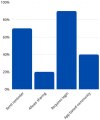Beyond the interface: benchmarking pediatric mobile health applications for monitoring child growth using the Mobile App Rating Scale
- PMID: 40607191
- PMCID: PMC12213656
- DOI: 10.3389/fdgth.2025.1621293
Beyond the interface: benchmarking pediatric mobile health applications for monitoring child growth using the Mobile App Rating Scale
Abstract
Introduction: As mHealth applications become increasingly adopted in Indonesia, it is crucial to assess their quality and usability for parents and healthcare professionals.
Aim: This study evaluated the quality of pediatric-related mobile health (mHealth) applications available in Indonesia, focusing on their ability to support child growth monitoring and provide educational resources for parents and caregivers.
Methodology: This is a cross-sectional study. From December 1, 2024, and January 31, 2025 we conducted systematic search for pediatric mHealth applications in Indonesian Google Play Store and Apple App Store using predetermined keywords. Inclusion criteria required the applications to be available in Bahasa Indonesia, focus on child health, and include growth tracking or stunting prevention features. We excluded applications that were not functioning during the testing period. Quality assessment was conducted by five healthcare professionals using the Mobile App Rating Scale (MARS). MARS assessed applications from multiple domains, including engagement, functionality, aesthetics, and information quality. Inter-rater reliability was ensured using the Intraclass Correlation Coefficient (ICC). The results were analyzed using descriptive statistics, Pearson's correlation, and T-tests. A p-value of <0.05 is considered to be statistically significant.
Findings: Nine applications were included in this study. Seven of the applications (77.78%) focused on tracking child growth and development and providing educational content. Less than half of the apps had built-in community features that enabled social support (n = 4, 44.44%) and features for feedback mechanisms & personalized guidance (n = 3, 33.33%) respectively. The majority were developed by commercial companies (n = 7, 77.78%). Quality assessment found significant variability across the apps, with high functionality and aesthetics scores but more variability in the domains of app engagement, quality of information, and subjective quality or perceived value.
Conclusion: This research underscored the need for the development of higher-quality, evidence-based mHealth apps for pediatric care in Indonesia, particularly in improving user engagement, feedback mechanisms and accessibility.
Keywords: assessment; digital health; e-health; pediatric care; stunting prevention; user experience (UX); user interface (UI).
© 2025 Irawan, Alristina, Laili, Amalia, Muharram, Miranda, Döbrössy and Girasek.
Conflict of interest statement
The authors declare that the research was conducted in the absence of any commercial or financial relationships that could be construed as a potential conflict of interest.
Figures










References
-
- Wang J-W, Zhu Z, Shuling Z, Fan J, Jin Y, Gao Z-L, et al. Effectiveness of mHealth app–based interventions for increasing physical activity and improving physical fitness in children and adolescents. Systematic review and meta-analysis. JMIR Mhealth Uhealth. (2024) 12:e51478. 10.2196/51478 - DOI - PMC - PubMed
-
- UNESCO. Global Education Monitoring Report 2023: Technology in Education – A Tool on Whose Terms? PARIS: Unesco; (2023).
LinkOut - more resources
Full Text Sources
Research Materials
Miscellaneous

